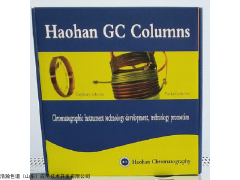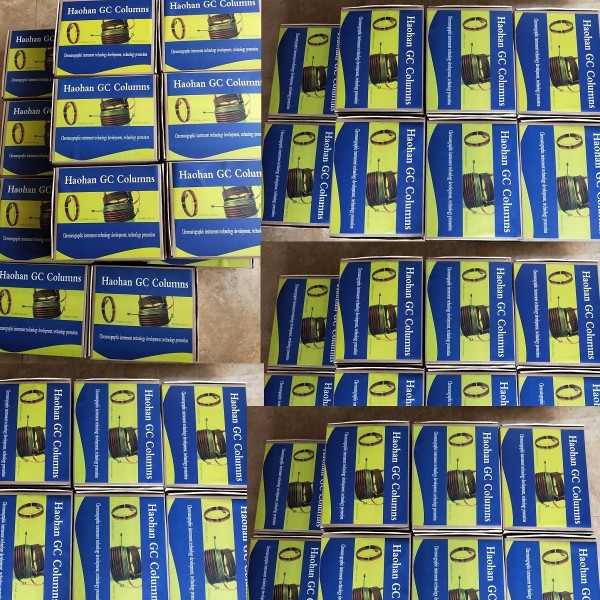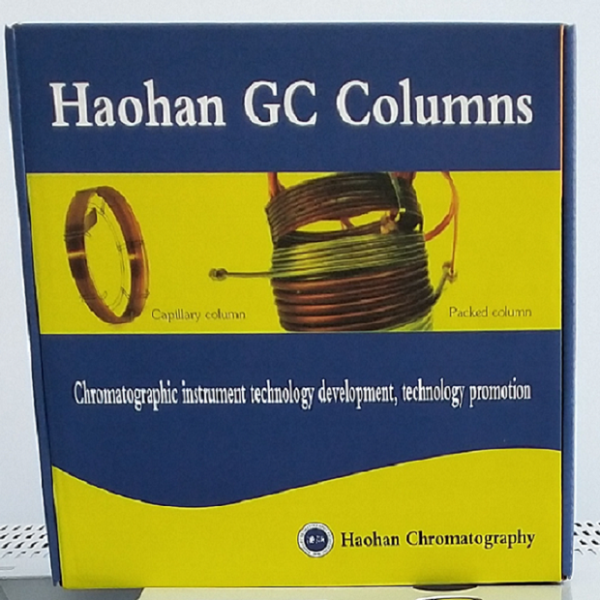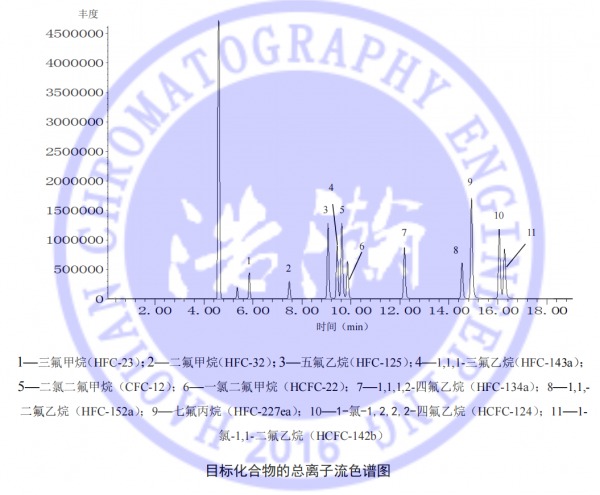
您当前的位置:首页 » 产品展示 » 毛细管柱 » PLOT 硅胶 毛细管柱测气态制冷剂 10 种卤代烃

| 产品名称: | PLOT 硅胶 毛细管柱测气态制冷剂 10 种卤代烃 |
| 产品型号: | PLOT 硅胶 |
| 品牌: | 1941 |
| 产品数量: | |
| 产品单价: | 面议 |
| 日期: | 2021-12-07 |
PLOT 硅胶 毛细管柱测气态制冷剂 10 种卤代烃的详细资料
毛细管柱测气态制冷剂 10 种卤代烃毛细管柱测气态制冷剂 10 种卤代烃 详细信息:
名称:毛细管柱
规格:60m*0.32mm
型号:多孔层开管毛细管柱PLOT 硅胶
应用:气态制冷剂 10种卤代烃的测定 气相色谱-质谱法
1 适用范围
本标准规定了测定气态制冷剂中三氟甲烷(HFC-23)、二氟甲烷(HFC-32)、五氟乙烷(HFC-125)、1,1,1-三氟乙烷(HFC-143a)、二氯二氟甲烷(CFC-12)、一氯二氟甲烷(HCFC-22)、1,1,1,2-四氟乙烷(HFC-134a)、1,1-二氟乙烷(HFC-152a)、1-氯-1,2,2,2-四氟乙烷(HCFC-124)和 1-氯-1,1-二氟乙烷(HCFC-142b)等 10 种卤代烃的气相色谱-质谱法。
本标准适用于气态制冷剂中 HFC-23、HFC-32、HFC-125、HFC-143a、CFC-12、HCFC-22、HFC-134a、HFC-152a、HCFC-124 和HCFC-142b 体积分数的测定,不适用于上述化合物纯度的测定。
当取样量为 20.0 μl,10 种卤代烃的方法检出限为 0.08%~0.09%;测定下限为 0.32%~0.36%。详见附录 A。
2 规范性引用文件
本标准引用了下列文件或其中的条款。凡是注明日期的引用文件,仅注日期的版本适用于本标准。凡是未注日期的引用文件,其新版本(包括所有的修改单)适用于本标准。
GB/T 3723 工业用化学产品采样安全通则
GB/T 6678 化工产品采样总则
GB/T 6681 气体化工产品采样通则
GB/T 26571 特种气体储存期规范
GB/T 37994 混合制冷剂采样通则
SN/T 2537 进出口制冷剂检验取样方法
3 术语和定义
下列术语和定义适用于本标准。
3.1
制冷剂 refrigerant
在制冷系统中用于传递热量的流体,在低温低压环境吸收热量,在高温高压环境释放热量,通常伴有相变过程。
3.2
气态制冷剂 gaseous refrigerant
在温度 20 ℃和压力 101.3 kPa 下呈气态的制冷剂。
4 方法原理
在一定的温度条件下,样品中的目标化合物在顶空进样瓶中混合并达到平衡后,经气相色谱分离,质谱检测器检测。通过与标准物质保留时间和质谱图相比较进行定性,内标法定量。
5 试剂和材料
除非另有说明,分析时均使用符合国家标准的分析纯试剂。实验用水为不含目标化合物的二次蒸馏水或通过纯水设备制备的水。
5.1 三氟甲烷(HFC-23),纯度≥99.5%,存储于钢瓶中,参照证书相关说明保存。
5.2 二氟甲烷(HFC-32),纯度≥99.5%,存储于钢瓶中,参照证书相关说明保存。
5.3 五氟乙烷(HFC-125),纯度≥99.5%,存储于钢瓶中,参照证书相关说明保存。
5.4 1,1,1-三氟乙烷(HFC-143a),纯度≥99.5%,存储于钢瓶中,参照证书相关说明保存。
5.5 二氯二氟甲烷(CFC-12),纯度≥99.0%,存储于钢瓶中,参照证书相关说明保存。
5.6 一氯二氟甲烷(HCFC-22),纯度≥99.6%,存储于钢瓶中,参照证书相关说明保存。
5.7 1,1,1,2-四氟乙烷(HFC-134a),纯度≥99.5%,存储于钢瓶中,参照证书相关说明保存。
5.8 1,1-二氟乙烷(HFC-152a),纯度≥99.5%,存储于钢瓶中,参照证书相关说明保存。
5.9 1-氯-1,2,2,2-四氟乙烷(HCFC-124),纯度≥99.5%,存储于钢瓶中,参照证书相关说明保存。
5.10 1-氯-1,1-二氟乙烷(HCFC-142b),纯度≥99.5%,存储于钢瓶中,参照证书相关说明保存。
5.11 内标化合物:1,1,1,2,3,3,3-七氟丙烷(HFC-227ea),纯度≥99.6%,存储于钢瓶中,参照证书相关说明保存。
5.12 4-溴氟苯(BFB)溶液:ρ(C6H4BrF)=25 mg/L,溶剂为甲醇的市售有证标准溶液,按照标准溶液证书相关说明保存。
5.13 氮气,纯度≥99.999%。
5.14 载气:氦气,纯度≥99.999%。
6 仪器和设备
6.1 取样导管:采用不锈钢或其他耐腐蚀金属管或聚四氟乙烯塑料管制作而成。取样前,将取样导管置于 110 ℃烘箱中烘烤 1 h,取样结束后应及时拆卸取样导管并妥善保管。保持导管清洁干燥,防止杂物或污物进入。现场样品采集时,用于连接大型钢瓶或集装压力储罐与气袋(6.2);实验室试样制备时,用于连接装有减压阀(6.3)的小钢瓶样品与气袋(6.2)。
6.2 气袋:氟聚合物薄膜气袋或铝塑复合膜气袋,带微量注射器取样阀,具可接取样导管(6.1)连接头,取样阀同时具备开启和关闭气袋功能。
6.3 减压阀:安装于样品小钢瓶瓶口,用于实验室取样时的气体减压。
6.4 气相色谱-质谱仪:色谱部分具有分流/不分流进样口,柱温箱可程序升温;质谱部分具有 70 eV 电子轰击离子源。
6.5 顶空自动进样器:具备定量环或进样针进样功能。
6.6 顶空进样瓶:瓶体为玻璃材质,密封垫为聚四氟乙烯/硅橡胶材质,密封盖为螺旋盖或一次性压盖, 20 ml,或与顶空自动进样器(6.5)配套的玻璃瓶。使用前拧(压)紧密封盖,确保顶空进样瓶的气密性。
6.7 色谱柱:多孔层开管毛细管柱,60 m(柱长)×0.32 mm(内径),固定相为键合硅胶,或其他等效毛细管柱。
6.8 注射器:气密性注射器,玻璃材质,10.0 μl,25.0 μl,250 μl,500 μl,100 ml。
6.9 一般实验室常用仪器和设备。
7 样品
7.1 样品采集与保存
样品采集前首先了解采集样品的实际情况,样品采集参照GB/T 6678、GB/T 6681和GB/T 37994相关规定执行,样品保存参照GB/T 26571和SN/T 2537相关规定执行。
样品存储于非重复充装钢瓶或重复充装钢瓶(容积W10 L,以下简称“小钢瓶”)时,按生产批次抽取,同一批号抽取1瓶小钢瓶样品,运回实验董;样品存储于贮槽、槽车或重复充装钢瓶(容积>10L)时,同一批号抽取1罐(瓶)采样,采样时,将取样导管(6.1)的一端与样品容器的采样口阀门连接,另一端与气袋(6.2)连接,打开阀材样品缓慢导入气袋(6.2),采样后,拧紧气袋阀门,采集2份平行样品,1份用于分析,1份作为留样保存。
采集的小钢瓶样品在常温密封条件下运输和保存,在装卸运输过程中,严禁撞击、拖拉、摔落和直接暴晒,应在阴凉干燥的地方存放,房间通风条件良好,不得靠近热源,严禁日晒雨淋;采集到气袋(6.2)的样品在常温下避光运输和保存,并存放在阴凉干燥的地方,7 d内检测完毕。
注:使用气袋釆样前,应检查并确保气袋(6.2)密封性良好;用氮气(5.13)清洗3次后备用;采样时,先用样品气清洗气袋(6.2) 3次,再釆集样品.
7.2 试样的制备
小钢瓶样品:先用氮气(5.13)清洗气袋(6.2) 3次,再用样品置换气袋(6.2) 3次,待用。将减压阀(6.3)连接小钢瓶,缓慢打开小钢瓶的阀门及减压阀(6.3),放出样品以置换减压阀(6.3)管路中气体。随后立即用取样导管(6.1)连接减压阀(6.3)和清洗后的气袋(6.2),打开减压阀(6.3),
让适量的气体样品转移气袋(6.2)中。小钢瓶样品取样示意图见图1。使用气密性注射器(6.8)从上述气袋中移取20.0 M样品经密封垫扎入顶空进样瓶(6.6)中,向顶空进样瓶(6.6)中加入1,1,1,2,3,3,3-七氟丙烷内标(5.11) 10.0μl,待测。
毛细管柱测气态制冷剂 10 种卤代烃 测试谱图:




Capillary column measurement of gaseous refrigerants 10 kinds of halogenated hydrocarbons
Capillary column measurement of gaseous refrigerants 10 kinds of halogenated hydrocarbons Details:
Name: Capillary Column
Specification: 60m*0.32mm
Model: Porous layer open tube capillary column PLOT silica gel
Application: gaseous refrigerant determination of 10 halogenated hydrocarbons gas chromatography-mass spectrometry
1 Scope of application
This standard specifies the determination of trifluoromethane (HFC-23), difluoromethane (HFC-32), pentafluoroethane (HFC-125), 1,1,1-trifluoroethane (HFC- 143a), dichlorodifluoromethane (CFC-12), mo
This standard applies to the volume fraction of HFC-23, HFC-32, HFC-125, HFC-143a, CFC-12, HCFC-22, HFC-134a, HFC-152a, HCFC-124 and HCFC-142b in gaseous refrigerants. The determination is not suitable for the determination of the purity of the above-mentio
When the sampling volume is 20.0 μl, the detection limit of the method for 10 halogenated hydrocarbons is 0.08%~0.09%; the lower limit of determination is 0.32%~0.36%. See Appendix A for details.
2 Normative references
This standard refers to the following docu
GB/T 3723 General rules for the sampling safety of industrial chemical products
GB/T 6678 General Rules for Sampling of Chemical Products
GB/T 6681 General Rules for Sampling of Gas Chemical Products
GB/T 26571 Special Gas Storage Period Specification
GB/T 37994 General Rules for Sampling of Mixed Refrigerants
SN/T 2537 Sampling method for im
3 Terms and definitions
The following terms and definitions apply to this standard.
3.1
Refrigerant
The fluid used to transfer heat in the refrigeration system absorbs heat in a low-temperature and low-pressure environment, and releases heat in a high-temperature and high-pressure environment, usually accompanied by a phase change process.
3.2
Gaseous refrigerant
It is a gaseous refrigerant at a temperature of 20 ℃ and a pressure of 101.3 kPa.
4 Principles of the method
Under certain temperature conditions, the target compounds in the sample are mixed in the headspace sample bottle and reach equilibrium, then separated by gas chromatography and detected by a mass detector. It is qualitatively compared with the retention time of the standard substance and the mass spectrum, and quantified by the internal standard method.
5 Reagents and materials
Unless otherwise specified, analytical reagents co
5.1 Trifluoromethane (HFC-23), purity ≥99.5%, stored in a steel cylinder, refer to the relevant instructions of the certificate for storage.
5.2 Difluoromethane (HFC-32), purity ≥99.5%, stored in a steel cylinder, refer to the relevant instructions of the certificate for storage.
5.3 Pentafluoroethane (HFC-125), purity ≥99.5%, stored in a steel cylinder, refer to the relevant instructions of the certificate for storage.
5.4 1,1,1-Trifluoroethane (HFC-143a), purity ≥99.5%, stored in a steel cylinder, refer to the relevant instructions of the certificate for storage.
5.5 Dichlorodifluoromethane (CFC-12), purity ≥99.0%, stored in a steel cylinder, refer to the relevant instructions of the certificate for storage.
5.6 Mo
5.7 1,1,1,2-Tetrafluoroethane (HFC-134a), purity ≥99.5%, stored in a steel cylinder, refer to the relevant instructions of the certificate for storage.
5.8 1,1-Difluoroethane (HFC-152a), purity ≥99.5%, stored in a steel cylinder, refer to the relevant instructions of the certificate for storage.
5.9 1-Chloro-1,2,2,2-tetrafluoroethane (HCFC-124), purity ≥99.5%, stored in a cylinder, refer to the relevant instructions of the certificate for storage.
5.10 1-Chloro-1,1-difluoroethane (HCFC-142b), purity ≥99.5%, stored in a steel cylinder, refer to the relevant instructions of the certificate for storage.
5.11 Internal standard compound: 1,1,1,2,3,3,3-heptafluoropropane (HFC-227ea), purity ≥99.6%, stored in a cylinder, refer to the relevant instructions of the certificate for storage.
5.12 4-Bromofluorobenzene (BFB) solution: ρ(C6H4BrF)=25 mg/L, the solvent is a commercially available certified standard solution of methanol, and it should be stored in accordance with the relevant instructions of the standard solution certificate.
5.13 Nitrogen, purity ≥99.999%.
5.14 Carrier gas: helium, purity ≥99.999%.
6 Apparatus and equipment
6.1 Sampling catheter: made of stainless steel or other corrosion-resistant me
6.2 Air bag: fluoropolymer film air bag or aluminum-plastic composite film air bag, with a micro-syringe sampling valve, with a sampling tube (6.1) connector, the sampling valve has the function of opening and closing the air bag at the same time.
6.3 Pressure reducing valve: installed at the mouth of the sample small steel bottle, used for gas pressure reduction during laboratory sampling.
6.4 Gas Chromatograph-Mass Spectrometer: The chromatographic part has a split/splitless inlet, and the column oven can be programmed to increase temperature; the mass spectrometer has a 70 eV electron bombardment ion source.
6.5 Headspace autosampler: It has the function of sampling loop or injection needle.
6.6 Headspace sampling bottle: the bottle body is made of glass, the sealing gasket is made of PTFE/silicone rubber, and the sealing cap is screw cap or disposable gland, 20 ml, or with the headspace autosampler (6.5) Matching glass bottle. Tighten (press) the sealing cap before use to ensure the air tightness of the headspace sample bottle.
6.7 Chromatographic column: a porous layer open-tube capillary column, 60 m (column length) × 0.32 mm (inner diameter), the statio
6.8 Syringe: air-tight syringe, glass material, 10.0 μl, 25.0 μl, 250 μl, 500 μl, 100 ml.
6.9 Commo
7 samples
7.1 Sample collection and storage
Before sample collection, first understand the actual situation of the collected samples. For sample collection, refer to the relevant regulations of GB/T 6678, GB/T 6681 and GB/T 37994, and for sample storage, refer to the relevant regulations of GB/T 26571 and SN/T 2537.
When the samples are stored in non-refillable cylinders or refilled cylinders (volume W10 L, hereinafter referred to as "small cylinders"), they shall be taken according to the production batch, and one small cylinder sample shall be taken from the same batch number and transported back to the laboratory; the samples shall be stored in When storing tanks, tank trucks or refilling steel cylinders (volume> 10L), one can (bottle) is sampled from the same batch number. When sampling, co
The collected small steel cylinder samples are transported and stored under sealed co
Note: Before using the air bag for sampling, check and ensure that the air bag (6.2) is well sealed; clean with nitrogen (5.13) for 3 times and then reserve; when sampling, first clean the air bag (6.2) with sample gas for 3 times, and then Collect samples.
7.2 Preparation of test samples
Small cylinder sample: first clean the air bag (6.2) with nitrogen (5.13) 3 times, then replace the air bag (6.2) with the sample 3 times, and then set aside. Co
Transfer an appropriate amount of gas sample to the gas bag (6.2). See Figure 1 for a schematic diagram of sample sampling from a small steel cylinder. Use an air-tight syringe (6.8) to remove a 20.0 M sample from the above air bag and put it into the headspace sample vial (6.6) through a sealing gasket, and add 1,1,1, to the headspace sample vial (6.6). 2,3,3,3-Heptafluoropropane internal standard (5.11) 10.0μl, to be tested.
Capillary column test gaseous refrigerant 10 kinds of halogenated hydrocarbon test spectrum: